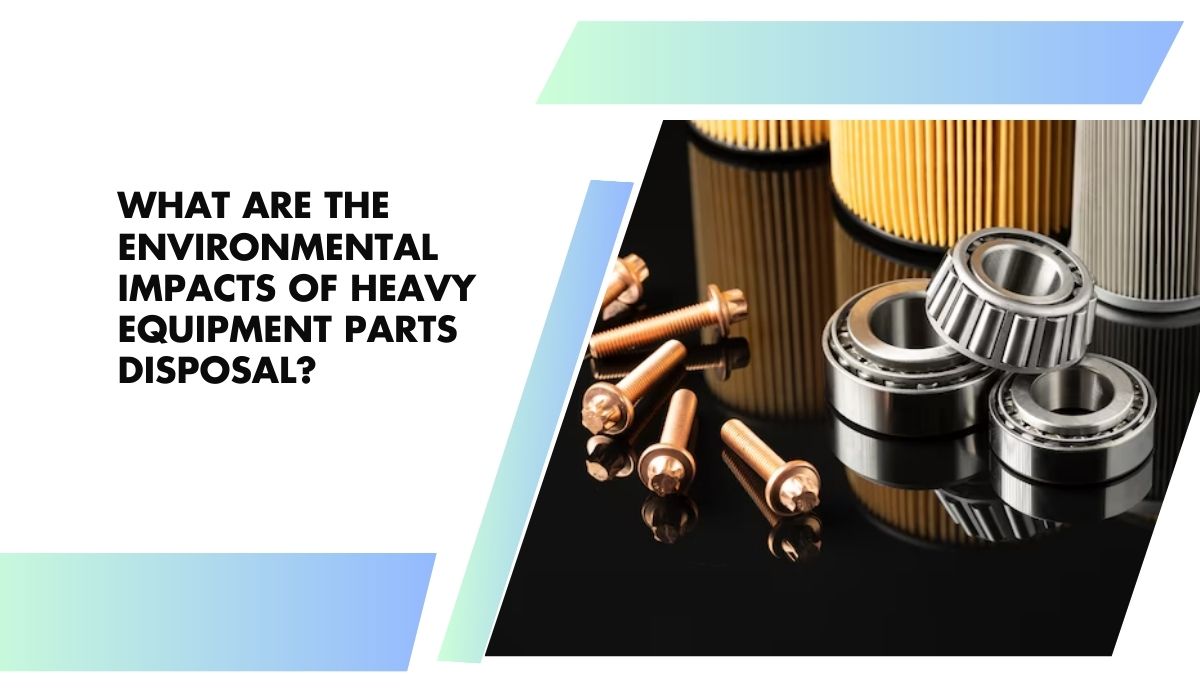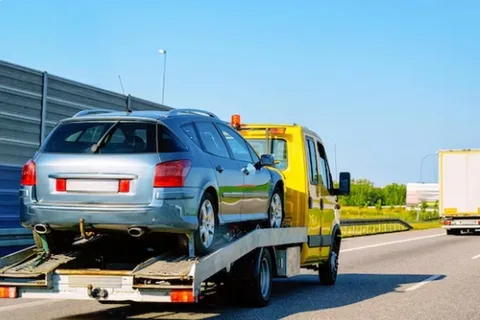Heavy equipment is crucial in industries like construction, mining, and agriculture, as it helps perform tough tasks more efficiently. However, as these machines age or break down, they need repairs and maintenance, often requiring the replacement of worn-out parts. While replacing parts is a necessary part of maintaining machinery, the disposal of heavy equipment parts can have significant environmental consequences.
In this article, we’ll explore the environmental impacts of heavy equipment parts disposal and discuss how businesses can take steps toward more sustainable practices. From toxic materials to landfill waste, the disposal process affects not only the environment but also local communities. By understanding these effects, businesses can adopt eco-friendly practices to mitigate the damage and contribute to a cleaner, healthier planet.
Understanding Heavy Equipment Parts Disposal
What Happens When Parts Are Disposed of?
Heavy equipment parts are often large, heavy, and made from a mix of materials, including metals, plastics, and rubber. When they are replaced or damaged, businesses must figure out how to dispose of them. Unfortunately, many parts end up in landfills or are incinerated, contributing to environmental harm.
Note: The best solution for your machinery starts with top-grade Heavy Equipment Parts in UAE. Get the parts you need on time, every time. Reach out to Premier Globe Equipment Trading LLC for unmatched service and product reliability. Don’t let equipment failures slow you down.
Disposal is a critical issue, especially when dealing with parts that are not biodegradable or recyclable. The environmental impact of improper disposal can be long-lasting, affecting soil, water, and air quality. This happens because certain materials in heavy equipment parts—such as oils, paints, and chemicals—are hazardous and can contaminate the surroundings.
Now let’s take a deeper look at the specific environmental consequences of heavy equipment parts disposal.
The Environmental Risks of Improper Disposal
Toxic Chemicals Leaching Into Soil and Water
Heavy equipment parts, such as batteries, filters, and hydraulic components, may contain hazardous chemicals like lead, mercury, or antifreeze. When these parts are improperly disposed of, they can leak toxic substances into the soil and water supply. These chemicals are harmful to plants, animals, and even humans.
For example, if hydraulic fluids or oils are not disposed of properly, they can seep into the ground, contaminating groundwater. Groundwater contamination can have long-term effects on local ecosystems and pose serious health risks for nearby communities who rely on well water.
The Problem with Non-Biodegradable Materials
Some heavy equipment parts are made from materials that are not biodegradable, such as plastics and certain metals. These materials can persist in the environment for hundreds or even thousands of years. When disposed of improperly in landfills or other areas, these parts can take up valuable space and contribute to long-lasting pollution.
For instance, rubber parts like tires are often not biodegradable. When discarded in landfills, they can accumulate over time and release harmful chemicals into the environment. These rubber waste piles are difficult to manage and can attract pests like mosquitoes, which may spread disease.
Air Pollution from Incineration
Another common method of disposing of heavy equipment parts is incineration. While burning waste may seem like a quick solution, it can have severe environmental impacts. Incinerating materials like plastics, rubber, and metals releases harmful gases, including carbon dioxide (CO2), dioxins, and furans, into the air. These pollutants contribute to air pollution and climate change.
The burning of heavy equipment parts may also release particulate matter, which can lead to respiratory issues and other health problems for people living nearby. As industrial waste incineration increases globally, the impact on the air quality and public health cannot be ignored.

How Heavy Equipment Parts Disposal Affects Local Ecosystems
Soil Contamination and Habitat Destruction
When hazardous materials from heavy equipment parts leak into the soil, they can disrupt local ecosystems. Plants and trees that rely on clean soil for growth may be affected, resulting in stunted growth or death. Animals that depend on the land for food and shelter may also be impacted, either by ingesting contaminated water or coming into contact with toxic substances.
For example, lead contamination from discarded batteries can harm soil quality, making it difficult for plants to grow. Contaminated soil also impacts the organisms that live in the soil, such as earthworms, which are crucial for healthy ecosystems. In the long run, this can lead to a decline in biodiversity in the affected area.
Impact on Water Bodies and Marine Life
Improper disposal of heavy equipment parts can also affect nearby rivers, lakes, and oceans. Chemicals and heavy metals can be carried by rainwater or runoff into water bodies, where they harm aquatic life. For instance, mercury from discarded batteries or hydraulic fluids can accumulate in the water and affect fish populations.
Marine animals, such as fish and turtles, can ingest small plastic particles or come into contact with contaminated water, leading to poisoning or death. This, in turn, affects the entire food chain, including humans who consume fish and other marine life.
The Role of Recycling in Reducing Environmental Impact
How Recycling Can Help
Recycling is one of the most effective ways to reduce the environmental impact of heavy equipment parts disposal. Many parts, including metals, rubber, and plastics, can be recycled and repurposed. Recycling not only reduces the need for raw materials but also helps keep harmful substances out of landfills and water systems.
For example, scrap metal from heavy equipment can be melted down and used to create new parts, reducing the need for mining and cutting down on pollution associated with raw material extraction. Similarly, rubber from tires can be recycled into products like playground surfaces or road materials, giving old parts a new life and reducing waste.
The Benefits of Sustainable Practices
Recycling heavy equipment parts not only helps protect the environment, but it can also benefit businesses. By adopting recycling programs, companies can reduce disposal costs, create new revenue streams, and improve their reputation as environmentally responsible businesses. This can be especially important in industries that are under increasing pressure to adopt sustainable practices.
For example, many construction companies are now looking for suppliers who use recycled materials in their heavy equipment, which can boost a company’s marketability. Sustainability has become a key selling point, and businesses that prioritize eco-friendly practices may gain a competitive edge.
Sustainable Alternatives to Traditional Disposal Methods
Repairing and Reusing Parts
Another way to reduce the environmental impact of heavy equipment parts disposal is by focusing on repair and reuse. Instead of discarding broken parts, companies can work with suppliers to repair and refurbish them. Rebuilding parts not only saves resources but also reduces waste. It’s a more sustainable practice compared to always replacing parts.
For instance, if a hydraulic pump or engine component is malfunctioning, it might be possible to repair it rather than replace it entirely. This can save the business money and extend the lifespan of equipment.
Using Eco-Friendly Materials
Heavy equipment manufacturers are increasingly developing products using eco-friendly materials that are easier to recycle and have less environmental impact. These materials are designed to reduce the amount of waste generated when equipment parts are replaced. By choosing equipment made from sustainable materials, businesses can significantly reduce their environmental footprint.
For example, manufacturers are developing biodegradable lubricants and using recyclable metals that are easier to process. By opting for equipment built with environmentally friendly materials, businesses can contribute to a more sustainable supply chain.
What Businesses Can Do to Improve Their Disposal Practices
Develop a Comprehensive Recycling Plan
One of the first steps businesses can take to reduce the environmental impact of heavy equipment parts disposal is to develop a recycling plan. This plan should include the identification of recyclable parts, a process for collecting and sorting materials, and a partnership with certified recycling centers.
Companies should also consider working with suppliers who prioritize sustainability and offer take-back programs for used parts. This ensures that parts are properly recycled and not discarded in landfills.
Educate Employees and Customers on Sustainable Practices
Education is key to improving disposal practices. Businesses should educate their employees about the importance of proper disposal and recycling. Additionally, educating customers about the environmental impact of waste and the benefits of recycling can encourage them to adopt more sustainable practices as well.
Creating awareness through workshops, training, and informational materials can help both employees and customers make better choices when it comes to disposing of heavy equipment parts.
Invest in Technology for Waste Management
Investing in technology that helps with waste management can also improve disposal practices. For example, businesses can use technology to track their waste production and ensure that all parts are being disposed of properly. Automated systems can help with sorting recyclable materials, making the process more efficient.
Investing in more eco-friendly equipment that produces less waste and operates with fewer harmful emissions can also make a big difference in the long term.
Conclusion: A Sustainable Future for Heavy Equipment Parts Disposal
The disposal of heavy equipment parts is a serious issue that can have long-lasting environmental consequences. Improper disposal leads to toxic chemicals, non-biodegradable materials, and pollution that harms local ecosystems, wildlife, and human health. However, businesses can take steps to reduce their environmental impact by recycling, reusing parts, and investing in more sustainable practices.
By adopting a more sustainable approach to heavy equipment parts disposal, businesses not only protect the environment but also contribute to the growing global effort to combat pollution and preserve natural resources. Through innovation, collaboration, and education, the heavy equipment industry can move toward a cleaner and greener future.
For More Insightful Articles Related To This Topic, Feel Free To Visit: viewsparrow.














